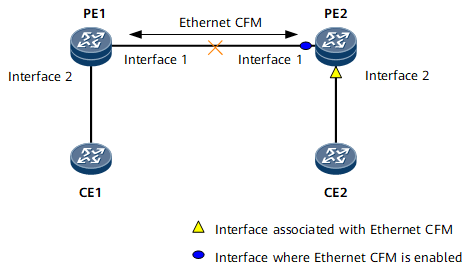Configuring Fault Message Transmission Between Ethernet CFM and Its Bound Interface
This section describes how to configure fault message transmission between Ethernet CFM and its bound interface in the OAM management view. After the configuration is complete, the link detection results of Ethernet CFM can be associated with the interface status.
Context
Pre-configuration Tasks
Before configuring fault message transmission between Ethernet CFM and its bound interface, configure basic CFM functions.
Procedure
- Run system-view
The system view is displayed.
- Run oam-mgr
The OAM management view is displayed.
- Configure the association depending on the usage scenario:
Table 1 Configurations for fault message transmission between Ethernet CFM and its bound interface Scenario
Configuration Solution 1
Configuration Solution 2
Deploying bidirectional fault message transmission between Ethernet CFM and its bound interface
Run the oam-bind cfm md ma trigger if-down interface or oam-bind interface cfm md ma trigger if-down command to configure bidirectional fault message transmission between Ethernet CFM and its bound interface.
NOTE:- The function of the oam-bind cfm md ma trigger if-down interface command is the same as that of the oam-bind interface cfm md ma trigger if-down command.
- The oam-bind ingress cfm md ma trigger if-down egress interface and oam-bind ingress interface egress cfm md ma trigger if-down commands are displayed in the configuration file.
You can also run both of the following commands used for unidirectional fault message transmission to configure bidirectional fault message transmission.
Run the following commands in any order (each command configures fault message transmission in a single direction):
- Run the oam-bind ingress cfm md ma trigger if-down egress interface command to configure Ethernet CFM to transmit fault messages to its bound interface.
- Run the oam-bind ingress interface egress cfm md ma trigger if-down command to configure an interface bound with Ethernet CFM to transmit fault messages to Ethernet CFM.
Deploying unidirectional fault message transmission between Ethernet CFM and its bound interface
Select either of the following commands based on the direction in which fault messages are transmitted:
To configure Ethernet CFM to transmit fault messages to its bound interface, run the oam-bind ingress cfm md ma trigger if-down egress interface command.
To configure an interface bound with Ethernet CFM to transmit fault messages to Ethernet CFM, run the oam-bind ingress interface egress cfm md ma trigger if-down command.
None
- Run commit
The configuration is committed.
